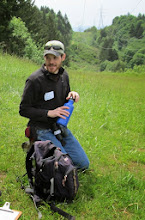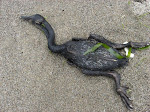The wetlands are divided into a northern and a southern unit.

Much of the north unit is flooded and contains tall willows.


This white pole marks my favorite point in the north section.

There is something fun about recording birds while standing in waist-deep water.
A few meters away from the point, I accidentally flushed a female cinnamon teal off of her nest in a tuft of grass.

I glanced in the tuft and spotted four small eggs just inches above the water. I waded away quickly, hoping that the female would soon return.
The southern unit is mostly a sea of canary grass growing up to seven feet tall in some areas.

At stations like these I can only see a few feet in each direction, so I need to rely on hearing alone to identify most birds.

I found a trampled path in the grass and found a pile of rodent-chewed willows. I had apparently discovered a beaver highway!

I rescued this cardinal meadowhawk from the road. It seemed to be too chilly for it to fly.
After a few hours wading through the water and swimming through the grass, I completed the survey and identified 38 species. As usual, the most common birds were red-winged blackbirds, song sparrows, marsh wrens, and common yellowthroats. The highlights for me were singing willow flycatchers, an osprey passing overhead, a few ravens, and the amazingly loud grunts of a Virginia rail. I will return in the next two weeks and seek more species.






No comments:
Post a Comment